© 2016 Your company
Barbie - all the references and tropes in the movie
One of the most striking and high-profile films of 2023 is Greta Gerwig's Barbie. Quite unexpectedly, this film became not just a girl's passable film for fans of everything pink, but a real cultural phenomenon with multiple references and deep morals.
Let's break down what Barbieland is all about, what interesting storytelling techniques the creators use, and what famous works are referenced.
Warning: there are a lot of spoilers in the text!
Let's break down what Barbieland is all about, what interesting storytelling techniques the creators use, and what famous works are referenced.
Warning: there are a lot of spoilers in the text!
The plot and structure of the puppet world
"Barbie" is a 2023 comedy-fantasy film based on Mattel's iconic line of fashion dolls. Greta Gerwig directed and co-wrote the screenplay with Noah Baumbach, and Margot Robbie produced and starred as the title character. David Heyman ("Harry Potter," "Paddington") is also a producer.
In the story, Barbie (Margot Robbie), who lives in the world of Barbieland, reflects on the nature of her existence after a series of unusual occurrences in her perfect life. This causes her to leave Barbieland and travel to the real world with her friend Ken (Ryan Gosling). Will Barbie be able to make sense of her new existential crisis, or will Mattel itself catch up with her and put her back in the box?
The first thing we see in the film is Barbieland. A beautiful town filled with friendly Barbies and Kens. Here the sun is always shining, the fashion is always on point, and the parties are always perfect.
It's a city of one palette: everything in Barbie's hometown is painted predominantly pink, including the dollhouses. So much pink paint was used to create the Barbieland sets that there was a global shortage of this particular shade.
In the story, Barbie (Margot Robbie), who lives in the world of Barbieland, reflects on the nature of her existence after a series of unusual occurrences in her perfect life. This causes her to leave Barbieland and travel to the real world with her friend Ken (Ryan Gosling). Will Barbie be able to make sense of her new existential crisis, or will Mattel itself catch up with her and put her back in the box?
The first thing we see in the film is Barbieland. A beautiful town filled with friendly Barbies and Kens. Here the sun is always shining, the fashion is always on point, and the parties are always perfect.
It's a city of one palette: everything in Barbie's hometown is painted predominantly pink, including the dollhouses. So much pink paint was used to create the Barbieland sets that there was a global shortage of this particular shade.
All female heroines (well, almost all of them) are named Barbie, although not all of them have perfect figures - only stereotypical Barbies, a tribute to the world's divergence. But everything in this world is subject to the rules of Barbie play that girls from the 60s to the 90s played by - there are no stairs in Barbie's house because the doll usually just climbed down from the top in her arms, all food and water doesn't spill, and even the shower doesn't spill water.

In addition to the perfect Barbies occupying the top positions in the city, there are also the Kens. And traditionally, Barbie and Ken are supposed to be together, but from the very beginning of the film it is clear that Barbie doesn't like Ken very much.
There are plenty of Ken's in Barbieland too, all of whom are handsome men but generally not very smart. They occupy a place here that in the real world is usually with beautiful but stupid girls.
There are plenty of Ken's in Barbieland too, all of whom are handsome men but generally not very smart. They occupy a place here that in the real world is usually with beautiful but stupid girls.
There are also other characters in this world, such as Midge, a pregnant doll, and Allan, made in the likeness of an Allan doll that existed at one time but was later discontinued.
Despite the fairy-tale likeability of the town's inhabitants, they are all bitches in sheep's clothing: the Barbies are extremely nice and friendly to each other, but they are still not very nice to those they consider "outsiders". They don't treat the Kens overtly badly, but they do show condescending compassion for men and generally treat them as second-class citizens.
Despite the fairy-tale likeability of the town's inhabitants, they are all bitches in sheep's clothing: the Barbies are extremely nice and friendly to each other, but they are still not very nice to those they consider "outsiders". They don't treat the Kens overtly badly, but they do show condescending compassion for men and generally treat them as second-class citizens.

Weird Barbie is gossiped about and treated as a weirdo for her strange appearance and knowledge of the outside world. Although Allan and Midge are allowed to be part of society, they are largely ignored and not considered part of the main group of Barbies and Ken. At the end of the film, after the Kens attempt to overturn the world order by taking over the Barbieland government and are subsequently overthrown, President Barbie recognises that this attitude needs to change. She invites Strange Barbie to join the government and allows the Kenes to take positions in the lower courts.
Speaking of Ken stupidity: Allan notices that a group of Ken builders are building a wall upwards, and so far they haven't figured out how to make it not just higher, but longer.
In addition to Barbieland, there's also the real world, where Mattel produces the Barbies that populate Barbieland and real girls play them.

The entire world of the film is set in the genre of "magical realism:" both Mattel's top executives and the FBI know about the existence of Barbieland and the possibility of Barbie crossing over to the other side, and the ghost of Ruth Handler, the doll's creator, has an office on the 17th floor. Both the real world and Barbieland seem to directly influence each other. Mattel employee Gloria's drawings "decide" what clothes Barbie will wear, even once in the real world, and conversely, Ken, by bringing ideas of patriarchy to Barbieland, turning it into Kendom, influences the toys that are created in the real world.

One of the striking, basic techniques of storytelling is the hero's journey on which the film's main plot is based. After all, Barbie goes to the real world to reclaim her place in Barbieland, and then to save Barbieland from Ken's misunderstanding of "patriarchy" - and in doing so, she passes all the "checkpoints" of the journey. This includes meeting her creator Ruth Handler and getting a moving insight from her into what Barbie was really created to be.
The very journey into the real world parodies the trope of "travel montage". Everyone travelling to and from Barbieland must ride rollerblades, a boat, a tandem bicycle through Tulip and Windmill Country ("beautiful countryside"), an RV, a rocket and a sports car, and the montage always shows the characters switching between different modes of transport out of frame.


When Barbie meets with Mattel executives, she is offered a quick return to Barbieland by placing her in a life-sized box-shaped package. This is the symbol of the new Barbie, also one of the rules by which this world functions. And at first, Barbie is even seduced by nostalgia.
Mattel's CEO is at first presented as a Big Bad, a big evil like Voldemort or Thanos. But he really isn't. He's a kind and well-meaning extremist who likes the Barbie brand and the ideas behind it, and is only trying to put the stereotypical Barbie back in her box to prevent "Stranger Things" in the real world.
The real Big Bad is Beach Ken, who, having discovered patriarchy in the real world, decides to bring it back to Barbieland, and his "knowledge" allows him to brainwash all the Barbies into becoming Ken's handmaidens, and turn Barbieland into a testosterone-poisoned parody of itself.
Mattel's CEO is at first presented as a Big Bad, a big evil like Voldemort or Thanos. But he really isn't. He's a kind and well-meaning extremist who likes the Barbie brand and the ideas behind it, and is only trying to put the stereotypical Barbie back in her box to prevent "Stranger Things" in the real world.
The real Big Bad is Beach Ken, who, having discovered patriarchy in the real world, decides to bring it back to Barbieland, and his "knowledge" allows him to brainwash all the Barbies into becoming Ken's handmaidens, and turn Barbieland into a testosterone-poisoned parody of itself.

Once more, with clarity - this is a rather popular technique, when events are first shown in one way, and then we are explained how things actually happened. You may recall the plot of the "Get Knives" films is based on this technique. In "Barbie" we see its use as well:
In trying to imagine the girl who is playing with her, the stereotypical Barbie first sees a little girl who has grown up and rejected Barbie's traditional femininity, and concludes that she needs to find common ground with this girl. When she meets Sasha and her mother Gloria, however, Barbie realises that it was Gloria who was playing with her as part of a minor mid-life crisis, and the flashback is shown again, but this time focusing on Gloria, who was previously out of frame.
In this way, the film kind of hints that it is for grown up girls, for those who played Barbie 20-30 years ago, and not for little girls for whom Barbie is not so important in their lives now.
In trying to imagine the girl who is playing with her, the stereotypical Barbie first sees a little girl who has grown up and rejected Barbie's traditional femininity, and concludes that she needs to find common ground with this girl. When she meets Sasha and her mother Gloria, however, Barbie realises that it was Gloria who was playing with her as part of a minor mid-life crisis, and the flashback is shown again, but this time focusing on Gloria, who was previously out of frame.
In this way, the film kind of hints that it is for grown up girls, for those who played Barbie 20-30 years ago, and not for little girls for whom Barbie is not so important in their lives now.
Gloria's climactic speech is very important. It expresses the Madonna-whore complex trope and emphasises the difficulties that modern women have to go through.
Gloria says it's "literally impossible" to be a woman because of all the double standards imposed by patriarchy.
It is mentioned that it is necessary to be beautiful and have children, and also touches upon the problems associated with the female mentality and all the contradictions that tear a woman from the inside and are imposed by society.
It is mentioned that it is necessary to be beautiful and have children, and also touches upon the problems associated with the female mentality and all the contradictions that tear a woman from the inside and are imposed by society.

Another technique that seems vaguely familiar to us is ironic echo. This is when events from the beginning of the film are repeated at the end, but in a different way (an example is the clapping of the main character in the film The Menu)
Barbie declines Ken's invitation to go to her house, saying that it's a hen party and that it's "Barbie's Dream House," not Ken's Dream House. Taking over Barbieland and her house, Ken throws a retort in her face and even asks her how it feels to be rejected.
Barbie declines Ken's invitation to go to her house, saying that it's a hen party and that it's "Barbie's Dream House," not Ken's Dream House. Taking over Barbieland and her house, Ken throws a retort in her face and even asks her how it feels to be rejected.

At the beginning of the film, stereotypical Barbie's outfits are traditionally pink, symbolising that Barbie is her essence. As she begins to fail, she wears blue clothing, symbolising her growing sadness, until she is introduced as Weird Barbie, at which point she is fully dressed in dark blue.
When she goes to the real world, she wears pink clothes again, as she feels optimistic that things will return to normal. When she returns to Barbieland and sees the "Kendom" that Beach Ken created, blue and pink patterns appear in her clothes, symbolising her inner conflict. Finally, when she decides to leave Barbieland and go to the real world, she is wearing yellow coloured outfits that are not found in other parts of Barbieland, signifying that she is no longer Barbie.
When she goes to the real world, she wears pink clothes again, as she feels optimistic that things will return to normal. When she returns to Barbieland and sees the "Kendom" that Beach Ken created, blue and pink patterns appear in her clothes, symbolising her inner conflict. Finally, when she decides to leave Barbieland and go to the real world, she is wearing yellow coloured outfits that are not found in other parts of Barbieland, signifying that she is no longer Barbie.

Overall, this is the first Barbie film not exclusively for children. It is a mature deconstruction of the franchise and its cultural influence, touching on adult themes such as existential crisis, toxic masculinity and the struggle for femininity, as well as the search for the real self and finding identity.
That is why we also see the "broken fourth wall" here:
When Barbie is worried that she can no longer live up to the unrealistic standards of beauty she represents, the voiceover announcer remarks that Margot Robbie's involvement in the role undermines the very meaning of the scene.
This also shows us the humour of the film makers, as even they acknowledge how perfect and "Barbiestereotypical" Margot Robbie is.
This also shows us the humour of the film makers, as even they acknowledge how perfect and "Barbiestereotypical" Margot Robbie is.

References within the Barbie and Mattel doll concept
The whole film is a huge "epoch" of Barbie's entire history over the decades. That's why we see many references to manufactured toys from the 60s, 70s and beyond. This is especially expressed in Barbie's costumes - all of which are chosen for a reason and existed in reality.
Even if some iconic Barbie outfits weren't used in the film, they were repeated by Margot Robbie during the press tour, which is also very curious.
Even if some iconic Barbie outfits weren't used in the film, they were repeated by Margot Robbie during the press tour, which is also very curious.
The Swimsuit that Barbie is wearing at the beginning is based on the outfit that came with the doll when it was first released in the 1950s.

Many of the dollhouses shown in "Barbieland" were sold as real toys for many years.
Midge was a pregnant Barbie who could then give birth to a baby from her belly. But she seemed strange to everyone and was very quickly discontinued.
Midge was a pregnant Barbie who could then give birth to a baby from her belly. But she seemed strange to everyone and was very quickly discontinued.

Barbie, played by Dua Lipa, is a blue-haired mermaid, which could be seen as a reference to Nori from Barbie Fairytopia or the blue-haired mermaid from the Dreamtopia line.

At the beginning of the film, Barbie comes off her heels... but her feet remain in the same position as the doll's. It's just like a real doll - there were no real feet inside her heels, though.
The font of the sign leading into the real world matches the font of the logo used in the 70s and 80s.
The font of the sign leading into the real world matches the font of the logo used in the 70s and 80s.
There's a shot at the beginning of the film where the stereotypical Barbie drives through an analogue of Mount Rushmore in Barbieland, which features the very first Barbie dolls - Christie, Kira and Theresa.
When Beach Ken brings the ideology of patriarchy to Barbieland, the dolls' faces are replaced with the faces of horses, as Beach Ken believes that horses are the defining symbol of masculinity.

Barbie is said to have 3 sisters - Skipper, Stacey and Chelsea. Skipper is the only one who appears in the film, at least indirectly. Chelsea's tree house appears, with drawings inside that have her name written on them. The voiceover video even showed the Chelsea logo in front of the treehouse, so Chelsea seems to exist in the film's universe, but she never appears.
The Bizarre Toys at Strange Barbie's Hideout - these are real strange dolls in Mattel products, which are later shown in the credits depicting the real toys and their marketing:
Tanner's pooping dog, known for being weird and rude,
Growing up Skipper (causing controversy with her simulation of puberty, including her growing breasts),
Video Girl Barbie (a strange doll with a camera in her chest and a screen in her back, discontinued after the FBI expressed concern that the video recording feature compromised children's privacy),
Sugar Daddy Ken (a strange man with a poorly chosen name),
Teen Talk Barbie (infamous for containing quotes perceived as sexist, such as "math class is tough! ") и
"Magic Ken with earrings" (infamous for its homosexual overtones).
Teen Talk Barbie is the only one of the characters to be overlooked, which makes her reference more subtle, and she can only be identified by her distinctive costume.
Tanner's pooping dog, known for being weird and rude,
Growing up Skipper (causing controversy with her simulation of puberty, including her growing breasts),
Video Girl Barbie (a strange doll with a camera in her chest and a screen in her back, discontinued after the FBI expressed concern that the video recording feature compromised children's privacy),
Sugar Daddy Ken (a strange man with a poorly chosen name),
Teen Talk Barbie (infamous for containing quotes perceived as sexist, such as "math class is tough! ") и
"Magic Ken with earrings" (infamous for its homosexual overtones).
Teen Talk Barbie is the only one of the characters to be overlooked, which makes her reference more subtle, and she can only be identified by her distinctive costume.
Allan is labelled as the only Allan, suggesting that he is the only such character in the line of dolls, and when he beats up Ken he says "I can wear your clothes!", boasting that one of the perk items on Allan's box (later shown in the credits) was that he can wear all of Ken's clothes.

One of the dolls Gloria and Sasha are holding appears to be Clara from "Barbie in the Nutcracker."
The stereotypical heart locket that Barbie wears while talking to Ruth's ghost seems to be a reference to the heart locket worn by Clara in The Nutcracker; just as Clara wanted to use her locket to return home but decided to stay in Parthenia, Barbie wears this heart necklace, realising that she has outgrown Barbieland and wants to become a full human being.
The stereotypical heart locket that Barbie wears while talking to Ruth's ghost seems to be a reference to the heart locket worn by Clara in The Nutcracker; just as Clara wanted to use her locket to return home but decided to stay in Parthenia, Barbie wears this heart necklace, realising that she has outgrown Barbieland and wants to become a full human being.

Filipino viewers may recognise the Filipino-style dress Gloria wore to honour her family's Filipino heritage. In the mid-1970s, Mattel opened factories in the Philippines in an effort to diversify production lines and cut costs. Mattel even produced a series of dolls dedicated to the Philippines and its culture. Admittedly, the film was banned from distribution in the Philippines. But more on that later.
References to other works
The film has a huge number of references, homages and allusions to other films/books and cultural phenomena. All of them probably can't even be listed, but let's start with the main ones.
The prologue parodies Stanley Kubrick's film"2001: A Space Odyssey": the monkeys are little girls, the bones are dolls, the monolith is Barbie herself, and the musical accompaniment is, of course, "Sunrise" from the song "Also sprach Zarathustra".
The prologue parodies Stanley Kubrick's film"2001: A Space Odyssey": the monkeys are little girls, the bones are dolls, the monolith is Barbie herself, and the musical accompaniment is, of course, "Sunrise" from the song "Also sprach Zarathustra".

When Ken has an epiphany in the real world, the background music is also a jazz version of the same "Also Sprach Zarathustra" by Eumir Deodato.
The city cinema in Barbieland is showing "The Wizard of Oz". The film is very similar in style to this film - there are the same "painted sets", they seem unrealistic, but because they are made of cardboard, they look very cute and atmospheric.
The city cinema in Barbieland is showing "The Wizard of Oz". The film is very similar in style to this film - there are the same "painted sets", they seem unrealistic, but because they are made of cardboard, they look very cute and atmospheric.
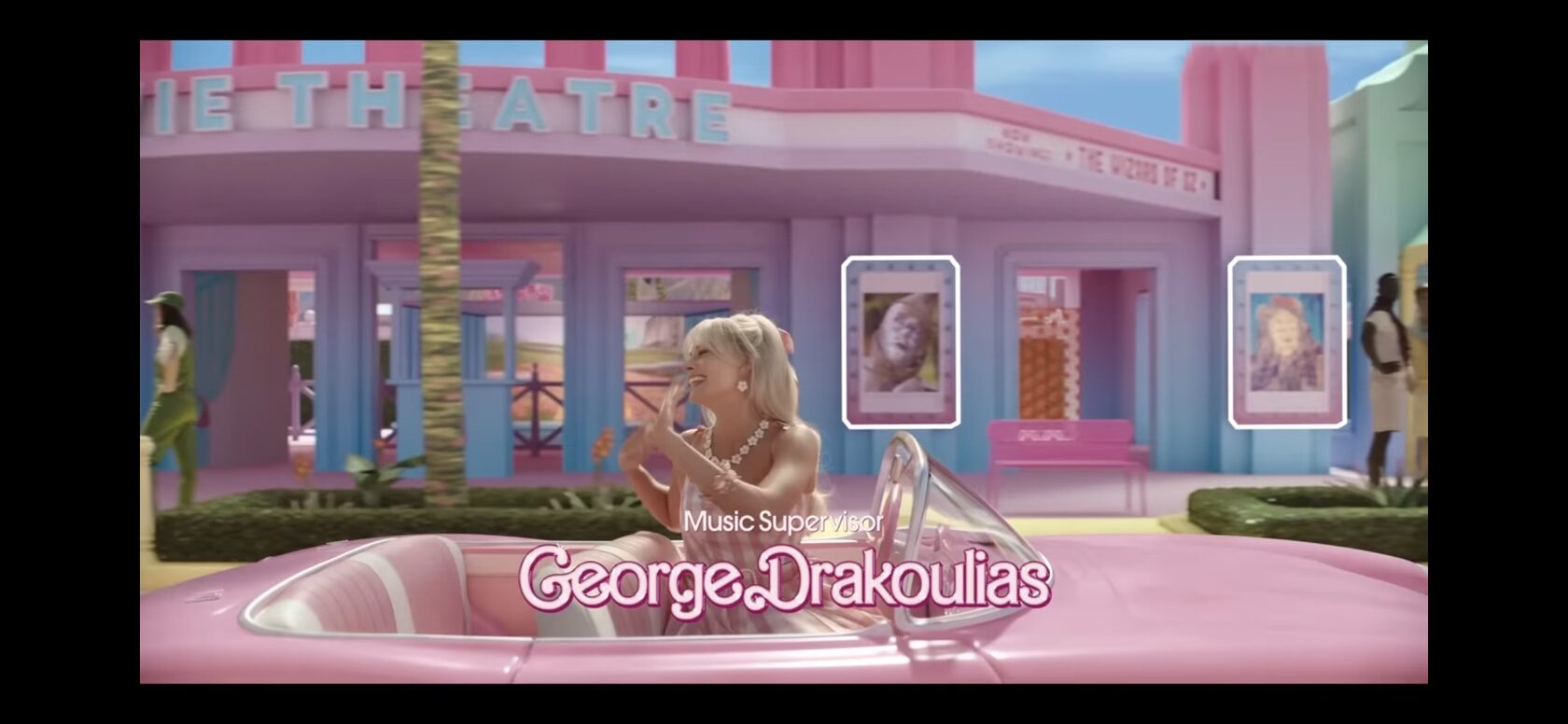
When Barbie first descends from the roof of her house, her dress is lifted in a Marilyn Manoeuvre style, referencing Marilyn Monroe in the film Itchy Year Seven.
When Barbie has to choose between two types of shoes, it looks like the "red pill" or "blue pill" sentence from "The Matrix".
Weird Barbie tells Barbie that she has to go to the real world, and she offers her a choice: take the high-heeled shoe and move on with her life, forgetting the bad things that happened, or take the brown Birkenstock sandals to learn more about the real universe. Barbie immediately chooses the former, but Weird Barbie tells her it doesn't work that way. When Barbie tries to choose the high heel, Weird Barbie tells her that she just gave the choice to create the illusion of control, and Barbie has no choice but to go to the real world to rectify the situation.
Weird Barbie tells Barbie that she has to go to the real world, and she offers her a choice: take the high-heeled shoe and move on with her life, forgetting the bad things that happened, or take the brown Birkenstock sandals to learn more about the real universe. Barbie immediately chooses the former, but Weird Barbie tells her it doesn't work that way. When Barbie tries to choose the high heel, Weird Barbie tells her that she just gave the choice to create the illusion of control, and Barbie has no choice but to go to the real world to rectify the situation.

A fragment from the film "Greased Lightnin'" is shown when Ken first learns about America's patriarchal society.
The image of Mattel's CEO and other executives gathered around a giant heart-shaped table is a direct reference to the War Room from "Dr Strangelove". And the corridors of the corporation are similar to the film Entertainment Time.
The image of Mattel's CEO and other executives gathered around a giant heart-shaped table is a direct reference to the War Room from "Dr Strangelove". And the corridors of the corporation are similar to the film Entertainment Time.
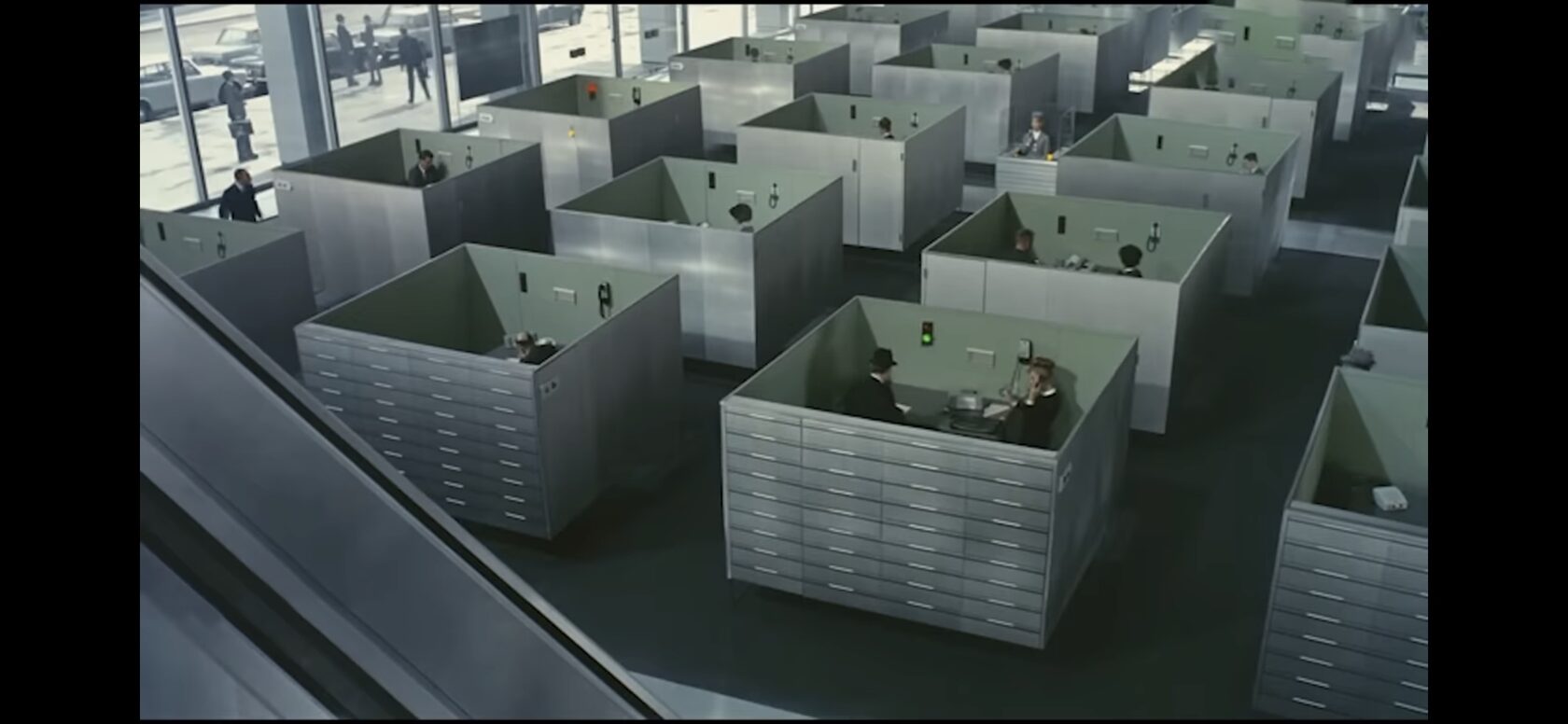
Part of Barbie's mission to trick the Kens into giving up Kendom involves hours of guitar jam sessions to their song "Push".
Margot Robbie was inspired by Katharine Hepburn's character from The Philadelphia Story.
Margot Robbie was inspired by Katharine Hepburn's character from The Philadelphia Story.

Barbie finds a girl who she thinks is playing with her sitting with her friends at a table in the school cafeteria. These friends include an African American girl, a blonde Caucasian girl, and an East Asian girl. Adding that the girl Barbie is looking for is a Latino teenager named Sasha is clearly a reference to another extremely popular line of dolls for girls, Bratz.
The Kens pretend to ride imaginary horses, much like King Arthur and his knights do in the film Monty Python and the Holy Grail.
During the battle, Ken can be seen in single suits and carrying batting sticks, much like in the film American Gladiators (which also featured toys from Mattel).
Ken is wearing black trousers with his name in the Metallica logo font after the establishment of patriarchy in Barbieland. His name is similarly labelled on an acoustic guitar he purchased. And the fur coat is a reference to Silvester Stallone and many other toxic-muscled images.
The Kens pretend to ride imaginary horses, much like King Arthur and his knights do in the film Monty Python and the Holy Grail.
During the battle, Ken can be seen in single suits and carrying batting sticks, much like in the film American Gladiators (which also featured toys from Mattel).
Ken is wearing black trousers with his name in the Metallica logo font after the establishment of patriarchy in Barbieland. His name is similarly labelled on an acoustic guitar he purchased. And the fur coat is a reference to Silvester Stallone and many other toxic-muscled images.
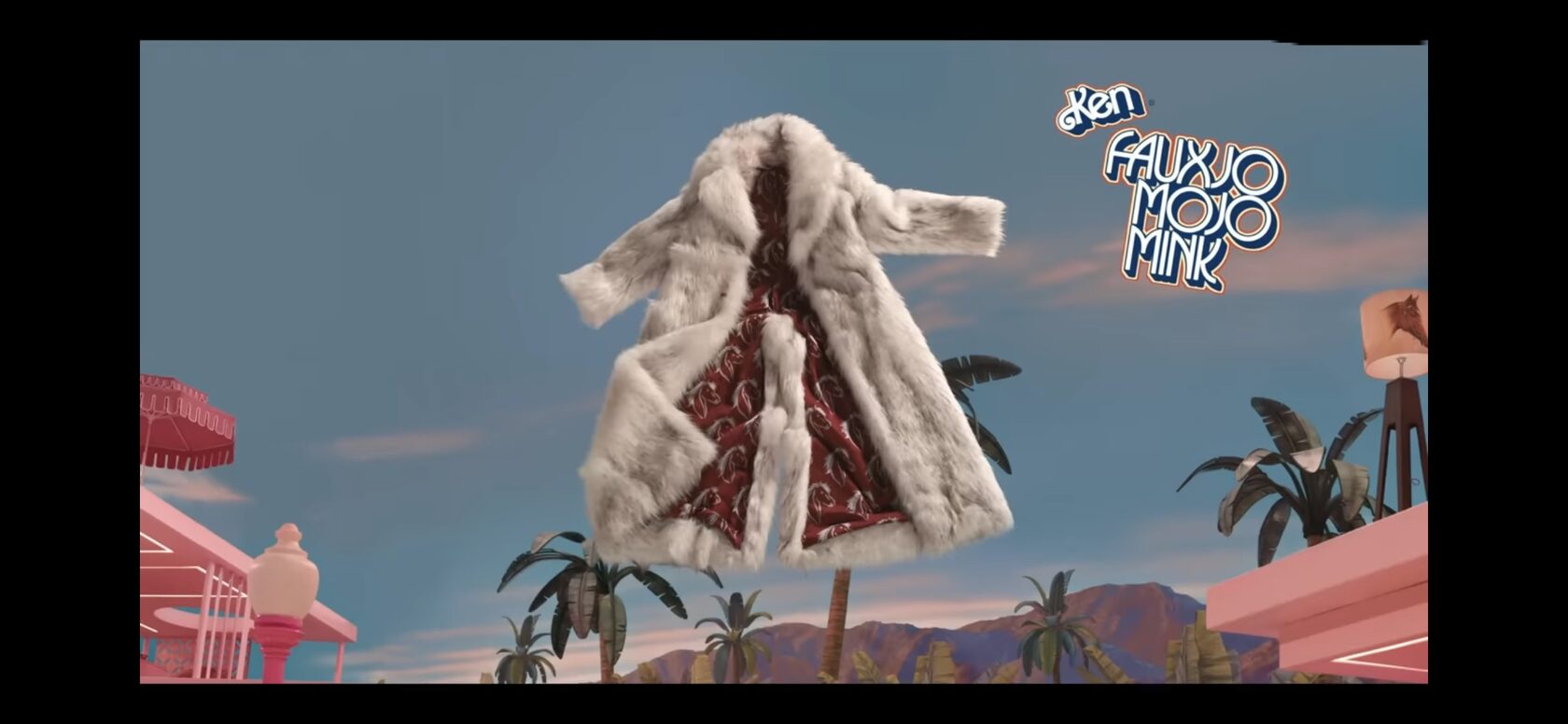

Both versions of the song "Pink" begin with the lyrics "When I wake up..." spoken in exactly the same cadence as in "I'm Gonna Be (500 Miles)".
As part of the brainwashing plan, President Barbie sits down with Ken, who is watching The Godfather, and makes the silly statement that she's never seen it, to which the latter, trying to impress her, rushes to explain its genius; he calls the film "a rich combination of Coppola's aesthetic genius and a triumph of Robert Evans and the architecture of the '70s studio system."
After being brainwashed, one Barbie stated that for some reason she was "very into the Zack Snyder-directed film Justice League". Amusingly, the main Barbie is played by the same actress as Harley Quinn.
Many of the film's stylistic choices refer us to the classics - "The Umbrellas of Cherbourg" and "Singin' in the Rain."
As part of the brainwashing plan, President Barbie sits down with Ken, who is watching The Godfather, and makes the silly statement that she's never seen it, to which the latter, trying to impress her, rushes to explain its genius; he calls the film "a rich combination of Coppola's aesthetic genius and a triumph of Robert Evans and the architecture of the '70s studio system."
After being brainwashed, one Barbie stated that for some reason she was "very into the Zack Snyder-directed film Justice League". Amusingly, the main Barbie is played by the same actress as Harley Quinn.
Many of the film's stylistic choices refer us to the classics - "The Umbrellas of Cherbourg" and "Singin' in the Rain."


In the third (at least) Stanley Kubrick film reference, Sasha asks if her mother and Barbie "glow", alluding to psychic powers from the film The Shining.
In an advert for a depressed Barbie toy, the toy watches the BBC film Pride and Prejudice (1995) seven times
In an advert for a depressed Barbie toy, the toy watches the BBC film Pride and Prejudice (1995) seven times
And here are a few other visual references

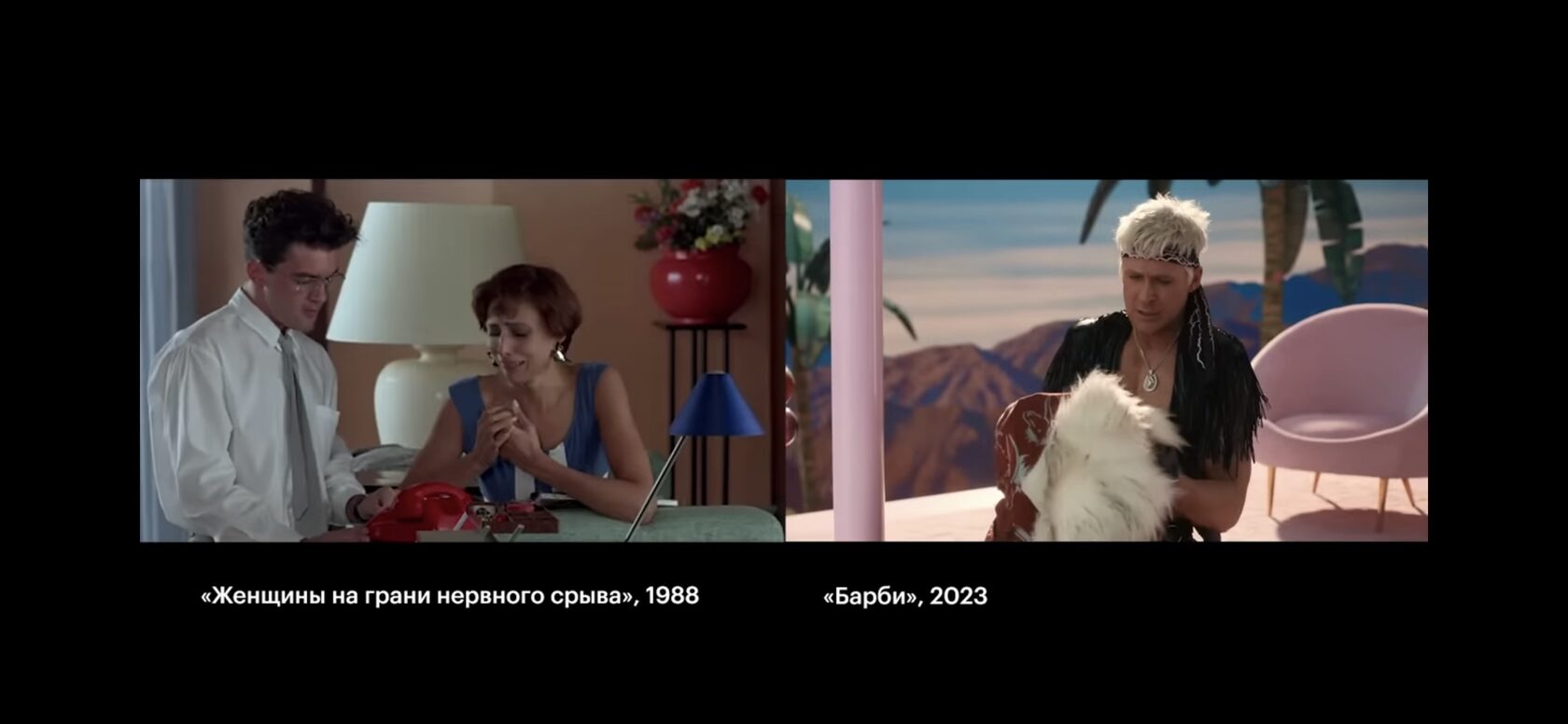
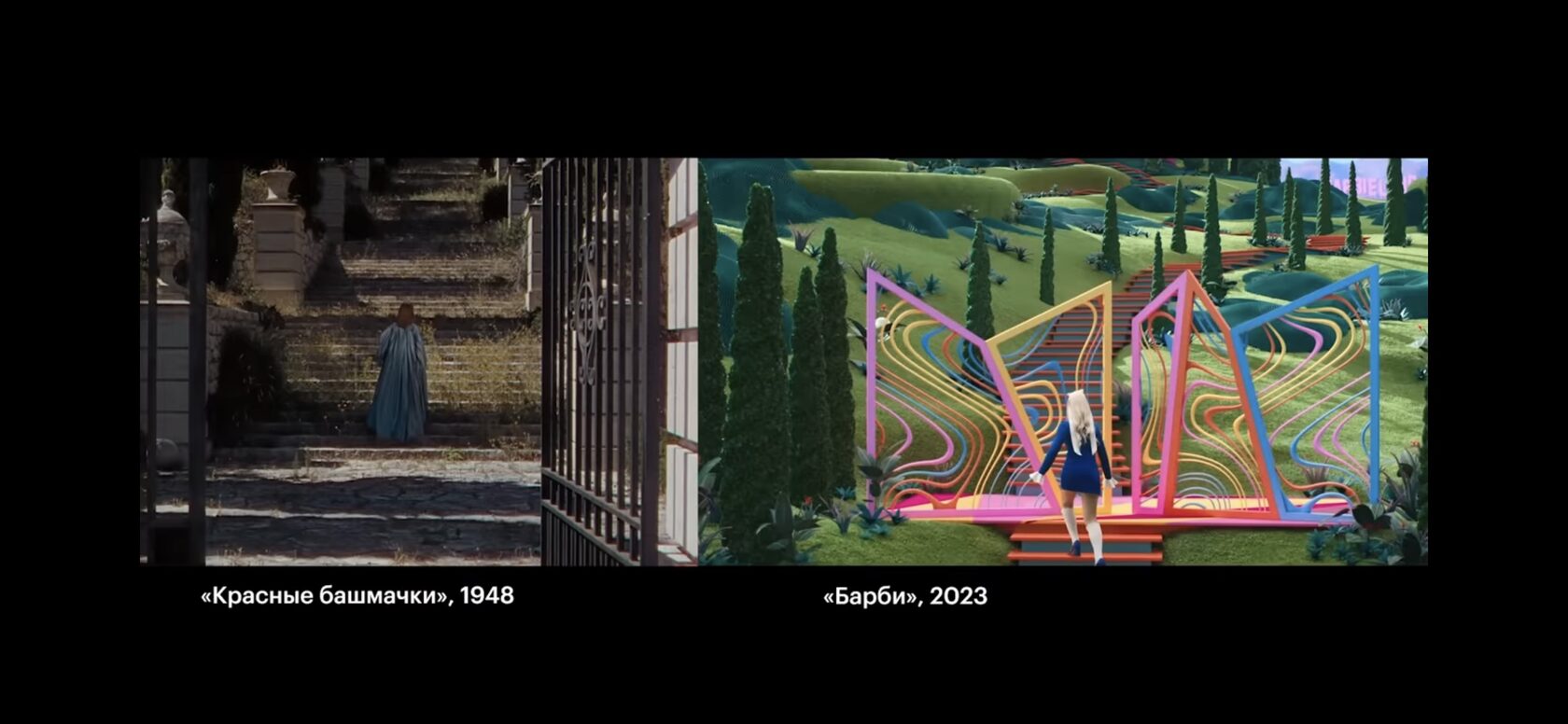
More interesting details and nuances of storytelling that you may not have noticed
Note the map that Strange Barbie shows to Barbie. There is no Russia on it at all, instead of Asian countries there is only Asia, which is why the film was banned in Vietnam and the Philippines, for example.
Allan and Midge are not in a romantic relationship, despite being introduced as a couple (and even getting married and having children) when they were first released. This is in keeping with the updated Barbie canon, which states that as of the early 2010s, Midge is not related to Allan in any way.
Allan and Midge are not in a romantic relationship, despite being introduced as a couple (and even getting married and having children) when they were first released. This is in keeping with the updated Barbie canon, which states that as of the early 2010s, Midge is not related to Allan in any way.

The Bait and Switch (when we are led to one thing and end up leading to another) - Gloria and Sasha drive Barbie to the building and give her words of encouragement, saying they are proud of her. It looks like she's going to a job interview - her first assignment as a real woman. The receptionist then asks her what she wants to do, and she confidently replies: "I'm here to see a gynaecologist."

Emma Mackay was chosen for the role in part because of her resemblance to Margot Robbie. In addition, Barbie Mackay is repeatedly paired with Ken Nkuti Gatwa, a reference to the fact that Mackay and Gatwa are the main characters in the TV series Sex Education.
And the actor who played Adam in that same Sex Education works in Mattel's office.
And the actor who played Adam in that same Sex Education works in Mattel's office.
Ryan Gosling agreed to play Ken after he went out into the garden and saw his daughter's Ken lying forgotten face down in the mud. It was then that he realised this story needed to be told.

In the Russian-language dubbing, Barbie uses feminitives characteristic of post-Soviet feminist jargon, for example addressing the Barbie president as "presidentka". Notably, only Barbie uses feminitives, but people in the real world do not.
The moral and key ideas of the film - and there are quite a few of them here
Never build your life and identity around one person, especially if that person doesn't feel the same way you do. Instead, try to realise who you really are.
Equality will not exist as long as one of the groups is at a distinct disadvantage.
No one can please everyone and be perfect. Everyone does their best to cope with the pressures of society.
Toxic, supremacist ideologies do no more good for the people who espouse them than they do for those they oppress. Both Barbie and Ken are ultimately unhappy and dissatisfied with the gender-supremacist systems they live in (and in Ken's case, create), and Ken explicitly admits that adopting a hyper-masculine lifestyle under patriarchy has not made him happy in the way that simply being able to be himself would. Also, mini-fridges are annoying and inconvenient, and it turns out that patriarchy as a concept doesn't have much to do with horses.
Power is the ability to live your life as you see fit, considering others and staying true to yourself, rather than just being in charge. Both Ken and the CEO of Mattel recognise that being a leader is difficult and yearn for simpler pleasures.
The real world is a complex, often dreary and frankly unfair place, not at all like the sanitised, overly idealistic world of children's toys. And that's okay.
Change is an inevitable (and difficult) part of life, and we must embrace it.
Equality will not exist as long as one of the groups is at a distinct disadvantage.
No one can please everyone and be perfect. Everyone does their best to cope with the pressures of society.
Toxic, supremacist ideologies do no more good for the people who espouse them than they do for those they oppress. Both Barbie and Ken are ultimately unhappy and dissatisfied with the gender-supremacist systems they live in (and in Ken's case, create), and Ken explicitly admits that adopting a hyper-masculine lifestyle under patriarchy has not made him happy in the way that simply being able to be himself would. Also, mini-fridges are annoying and inconvenient, and it turns out that patriarchy as a concept doesn't have much to do with horses.
Power is the ability to live your life as you see fit, considering others and staying true to yourself, rather than just being in charge. Both Ken and the CEO of Mattel recognise that being a leader is difficult and yearn for simpler pleasures.
The real world is a complex, often dreary and frankly unfair place, not at all like the sanitised, overly idealistic world of children's toys. And that's okay.
Change is an inevitable (and difficult) part of life, and we must embrace it.
Why is "Barbie" so popular?
Why didn't this film become just another in a string of 2023 summer movies, but truly shook up the world?
Of course, it's not just about the colourful ad campaign, although it's lovely, there's no arguing that.
The fact is that Barbie is something close to a large number of people, grown up girls who have warm feelings and nostalgia for their childhood.
Of course, it's not just about the colourful ad campaign, although it's lovely, there's no arguing that.
The fact is that Barbie is something close to a large number of people, grown up girls who have warm feelings and nostalgia for their childhood.
In addition, there is a strong nostalgia for the 90s, to which Barbie, with her colourful costumes and singing characters, also refers. Feminism is still not out of fashion.
And just as fashion is cyclical, it is replaced by black and sombre oversize pieces with bright colours and feminine cuts, which is also supported by the barbicore concept.
And just as fashion is cyclical, it is replaced by black and sombre oversize pieces with bright colours and feminine cuts, which is also supported by the barbicore concept.

And in the end, it's just a good film, telling a good and multi-layered story, where there is room for pop culture, art house, and our childhood memories. And, most importantly, the moral of the film is not childish at all, expressed in the writing on Ken's sweatshirt in one of the last scenes.
"I am Kenough" is written on it, which is a play on words from Ken + enough, enough, in English. So we all need to come to a world where you are enough. And then build something on top of that.
"I am Kenough" is written on it, which is a play on words from Ken + enough, enough, in English. So we all need to come to a world where you are enough. And then build something on top of that.

